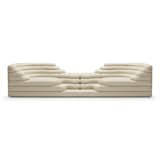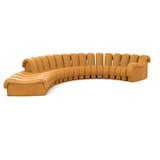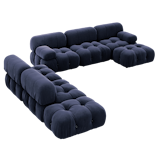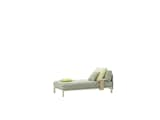Welcome to Field Guide, a column by Sami Reiss of Snake covering all-time design and where you can find it.
Amanda Pratt landed on modular when moving from her Williamsburg apartment to a Soho loft a couple years ago. “I had all this cool vintage furniture and couldn’t fit it into the building’s elevator,” says the interior architect and the owner of Salon Design, a Tribeca gallery. She custom ordered a modular sofa from Ffabb, a Canadian home furniture shop, and brought it into her place piece by piece. She’s since moved it around. Beyond the convenience, Pratt likes what she calls the sofa’s “flexibility of purpose.” The sofa, in her words, “takes up a lot of space in a way that makes sense.”
Modular sofas are more desirable now than they’ve been in a while. Important archival ones—like Ubald Klug’s descending Terrazza, and the ubiquitous Togo, both from 1973—are severely collectible and more expensive than they were a decade ago, regularly fetching high prices at auction. Searches for modular furniture, according to Google Trends, are also at a high, showing an aggressive upswing since 2004, which is when tracking for the data began. They have more than tripled in earnest since 2019. There are also now more accessible retail options than ever before—some direct to consumer, and dubious, and others from the likes of Ikea that provide an accessible entry point to the style.
In some cases, a modular sofa solves a spatial problem, as it did for Pratt. In others, the style makes a home’s living space multiuse. Earlier in June, at 3 Days of Design in Copenhagen, Vitra, the Swiss mobilier, debuted a modular sofa by Swiss design consultancy Panter & Tourron that it hopes is the latest addition to the functional canon. The Anagram, which will be available this September, is a “flexible platform” for seating, says the consultancy’s design principal Alexis Tourron. What it achieves feels fresh: A “non-directional object,” the sofa isn’t designed to face a TV (or fireplace), and so can be arranged in more ways than a unidirectional sofa—or even some older ’70s modular models. Even with its broad footprint, logistically it’s smaller than it looks. The Anagram’s break-apart tech makes it easier to get it into a New York apartment than a traditional sofa.
Vitra’s new piece and more of today’s modular sofas are an inevitable progression from the functional, flexible furniture—and architecture—that evolved in the 20th century. As furniture that can come apart and is designed, so to speak, by the customer, modular encompasses rectangular storage, extendable from a small shelf to a wall, a bubbly sofa that can take over a room, and many things in between. This recombination and flexibility helps individuals with mutable living situations: an XL, four-piece modular sofa might be a centerpiece in a big apartment—with roommates—and get split up in a smaller one bedroom, or a house.
Modular as a concept, says Ron Witte, professor in residence of architecture at Harvard’s Graduate School of Design, may date as far back as the 18th century. “It really became formalized in the 1920s,” he says. Witte cites Peter Behrens’s 1910 factory design, for AEG, the German electrical equipment manufacturer, as a prime example of modular: The factory was “modular in how it was laid out—repeated bays of structural columns—and the way that it was used.” The factory space was flexible, and was able to accommodate improvements to its line. By the 1940s, modular design, specifically the flexible architecture of Herman Hertzberger, which allowed for multiple uses, became prominent for office spaces. Regarding furniture, other accounts place the genesis with Harvey Probber. An American designer, Prober catered to interior designers by producing almost anti-Eames furniture from the ’50s on. His most popular modular designs—big, regal sofas, like the Cubo and the Deep Tuft—were made up of smaller parts, like corner wedges, that created something more than a whole.
The bubbly modular aesthetic with sofas first peaked between 1970 and 1975. In the ’60s—during America’s short countercultural revolution—”people were loosening up,” says Witte. Those same people, in the ’70s, had more disposable income. Sofas then were “a reinvention of a different kind of lifestyle,” one that was more informal and loungy than what came out of strict ’20s futurism and its emphasis on the office environment. Pieces like the Terrazza departed from traditional sofas—and earlier, upright pieces by Probber—that predominated furniture beforehand. Says Witte of “proper” sofas: “You sat on them a certain way, you were upright, and your posture was correct.” Compare this to how one might use De Sede’s long, undulating and low-slung Snake sofa, which takes over a room with its horizontality, or even a beanbag chair—a more downmarket expression, Witte says, of the ’70s modular style.
These expressive couches were preceded by clinical, sometimes industrial storage options designed in the 1960s for office environments—think Vitsoe and USM Haller’s modular systems. They tended to fall into two categories. There are the elegant, designed items that happen to be modular: massive sofas like De Sede’s Snake, and the Mah Jong, by Roche Bobois, which stretches out flat, sometimes with pattern clash. In the same group is Klug’s Terrazza, which feels like a lazy set of mountains, and the Camaleonda, by B&B Italia, which is bubbly, rich, and low to the ground. For these sofas, Witte says, “the curve shape superseded the module.” These are pieces which are defined by their aesthetic, and which just happened to be connectable—often with screws—and could be split apart. The module was secondary to the design, says Witte, and antagonistic to the gridded, 1920s modular concepts.
In the second category are pieces that put theory on display, like Roberto Matta’s Malitte seating system, which, when completed, stands vertically like a sculpture, and Archizoom’s hard-shelled Safari. The building blocks are exposed, and the idea of sitting down is more experimental. The pieces are also not complete when they’re literally connected; they’re better when loosely arranged.
Both sets of modular seating, though, ask questions: How simple must furniture be? What can it do? And how should people use it? They answer them with a dare: a sofa doesn’t have to be simple or reined in, and can do more than we think, and can be used however we want.
Design that followed these more experimental pieces was markedly different, if not in looks then in scope. By the 1980s, furniture, says Witte, became more self-referential and “less concerned with the life carried out on them.” Think of how Sottsass’s big storage pieces, like the Casablanca and Carlton, comment on every cabinet before them, and are halfway impractical. “The point,” says Witte, “became the furniture piece itself.”
Some modular work sits outside this aesthetic tradition and draws from a different set of ideas. Loose Parts, a design studio in Hudson, N.Y., makes a series of what founder Jennifer June calls an “open sourced system” of cabinets and seating. Pieces are constructed from three materials—hardwood, aluminum paneling, and steel fasteners—and can be rearranged after purchase without use of a tool. June’s reined-in Lorenza Daybed, or her series of shelves, are starker and more spare than the ’70s Italian stuff, but as, or more, flexible. Modular, says June, offers “guard rails”: a set of rules for what the piece can do—and how it can be rearranged. The work is influenced strongly by other open-source systems. Ad hoc design, which June shades out as “old furniture that needs ingenuity, and which has no adhesives,” gives work a craftsman feel, like the cobbled-together chess tables in New York’s Union Square. Loose Parts’s tech determines its look, and both take influence from Ken Isaacs, who wrote an instruction manual on how to build your own furniture with metal beams, and Grid Beam’s latticed-wood output, which was similar to Isaacs’s productions. June also counts William Whyte, and his writing about public spaces, as an influence, as well as the Whole Earth Catalog and its emphasis on DIY.
In the middle of poppier archival work and Loose Parts’s stricter output is Vitra’s Anagram. At Vitra’s showroom at 3 Days of Design, the sofa struck me as a successful execution of fabrication techniques and small details. It’s minimal, with a shape that’s anonymous at first glance, and which evolves, after a few viewings, to conversing with Corbusier’s famous LC2 chair, though softer and less imposing. Splayed out with a handful of unalike fabric and configuration options, each variation of the sofa had its own look. A bigger “platform”—or base—shaped like a donut, with darker fabrics and a contrasting backrest, came off as more playful than a longer, soft off-white Nubia version that was quiet and contained.
The new sofa felt like an inversion of Witte’s description of the loud ’70s modular example: this one was more about the modularity than the curve. The designers later confirmed as much at a presentation, with Tourron describing the Anagram as a “minimal design that is highly configurable,” and explaining that “the fabrics give the identity to the product.” The multidirectionality, switchable backrests and hook system—the key tech piece here, and what makes it all variable—feel workable, and a big enough achievement to allow for more looks down the line.
Beneath the quiet design sit the same questions the ’70s designers asked about how we live, and what furniture means to working people. Along with Eames, and its reliance on function, P&T count Superstudio a main influence, specifically how the ’70s Italian design collective “oversees the utopia,” says principal Stefano Panterotto. (Superstudio asked, among other things, why shouldn’t sofas be outside? And do we need actual buildings?) “Those two universes merging together,” says Tourron, referring to Eames and Superstudio, “made the Anagram sofa.” It asks, in a less incendiary way, some of what Superstudio wrote out in its 1960s manifesto about furniture—why is design the way it is?—and answers it with Eamesian function.
But we might also ask why there’s not much variety of modular work today compared with the ’70s. Or why the technology, apart from the Anagram, sits so heavily on screws and connections. Shouldn’t there be as many couches and storage options out there as there are ways to connect them? Shouldn’t there be more than one look? To be sure, part of the penury here comes from the current state of furniture production. It’s expensive to make well-produced pieces, to say nothing of how investing in new technology can shift the way we think about seating. One can hope that with the simple hook system now out there, that will change, and more workable modular pieces will be produced in the future. As good as the stuff looked in the ’70s, modular can do much more than just catch our eye.
—
Vitra’s Anagram will officially be released in September of this year. While we wait, here’s where to find pieces from the modular sofa’s golden era of experimentation.
Ubiquitous
The Terrazza sofa, designed in 1973 by Ubald Klug, doesn’t show up consistently on auction sites, but when it does it can sometimes go under the radar. Within the past couple of years, items have ended in the $13,000 range.
Sleeper
De Sede’s Snake sofa is is appropriately named, and can go on endlessly, which makes it a perfect moodboard sofa; it tends to run at less than $20,000 on LiveAuctioneers, and is cheaper when sold overseas.
Rare
Roberto Matta’s Malitte sofa isn’t really a set of seats but an idea—the idea being that it looks like way too much fun to be actual furniture for adults. It now and then flies under the radar; a recent piece on auction sold for just $4,000; one is on sale at press time for $10,000.






















